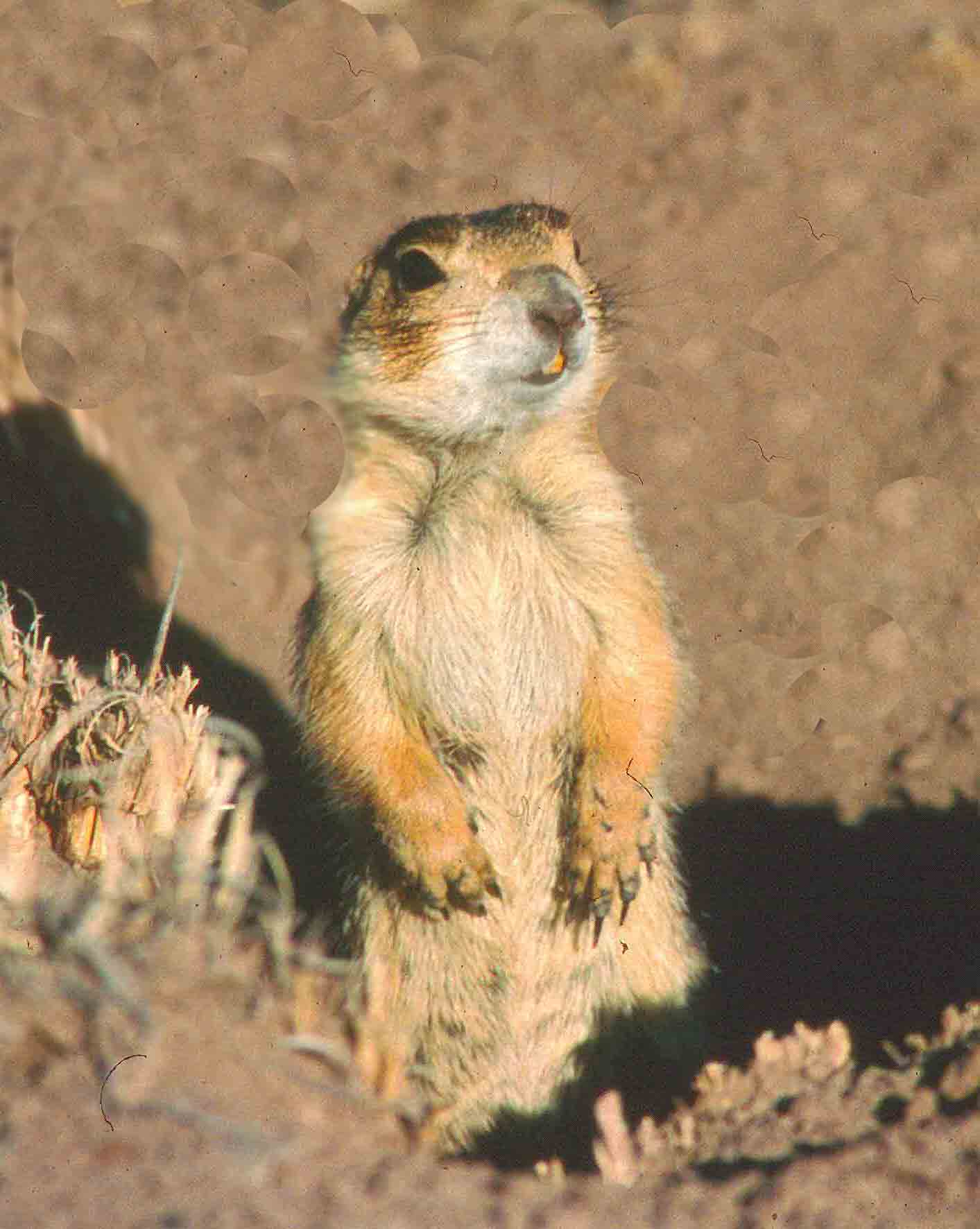Con Slobodchikoff
Professor Emeritus, Biology Department, Northern Arizona University

Address:
Con Slobodchikoff
Department of Biology,
Northern Arizona University
Flagstaff, AZ 86011
Phone: (928)-523-7231
Fax: (928)-523-7500
E-mail: Con.Slobodchikoff@nau.edu
Ph.D.: University of California, Berkeley.
B.S.: University of California, Berkeley.

Research Topics
Animal communication systems:
For further information, see the following:
- Slobodchikoff, C. N. and R. Coast. 1980. Dialects in the alarm calls of prairie dogs. Behavioral Ecology and Sociobiology 7: 49-53.
- Slobodchikoff, C. N., C. Fischer, and J. Shapiro. 1986. Predator-specific words in prairie dog alarm calls. American Zoologist 26: 557 (Abstract)
- Slobodchikoff, C. N., Judith Kiriazis, C. Fischer, and E. Creef. 1991. Semantic information distinguishing individual predators in the alarm calls of Gunnison's prairie dogs. Animal Behaviour 42: 713-719.
- Slobodchikoff, C. N. 1998. The language of prairie dogs. pp. 65-76. in: M. Tobias and K. Solisti-Mattelon, eds. Kinship with the animals. Beyond Words Publishing, Hillsboro, OR.
- Kiriazis, Judith and C. N. Slobodchikoff. 1996. Anthropocentrism and the study of animal language. in: R. W. Mitchell, N. S. Thompson, and H. L. Miles, eds. Anthropomorphism, anecdotes and animals. SUNY Press, pp.365-369.
- Slobodchikoff, C. N., S. H. Ackers, and M. Van Ert. 1998. Geographical variation in alarm calls of Gunnison's prairie dogs. Journal of Mammalogy 79: 1265-1272.
- Ackers, S. H. and C. N. Slobodchikoff. 1999. Communication of stimulus size and shape in alarm calls of Gunnison's prairie dogs. Ethology 105: 149-162.
- Placer, J. and C. N. Slobodchikoff. 2000. A fuzzy-neural system for identification of species-specific alarm calls of Gunnison's prairie dogs. Behavioural Processes 52: 1-9.
- Placer, J. and C. N. Slobodchikoff. 2001. Developing new metrics for the investigation of animal vocalizations. Intelligent Automation and Soft Computing 7: 1-11.
- Slobodchikoff, C. N. 2002. Cognition and communication in prairie dogs. pp. 257-264 in: Bekoff, M., C. Allen, and G. Burghardt, eds. The Cognitive Animal, MIT Press.
- Verdolin, J. and C. N. Slobodchikoff. 2002. Vigilance and predation risk in Gunnison's prairie dogs. Canadian Journal of Zoology 80: 1197-1203.
- Perla, B. and C. N. Slobodchikoff. 2002. Habitat structure and alarm call dialects in the Gunnison's prairie dog (Cynomys gunnisoni). Behavioral Ecology 13: 844-850.
- Slobodchikoff, C. N. 2002. The language of prairie dogs. Plateau 6: 30-38.
- Placer, J. and C. N. Slobodchikoff. 2004. A method for identifying sounds used in alarm call classification. Behavioural Processes 67: 87-98.
- Dahlin, C. R., R. P. Balda and C. Slobodchikoff 2005. Food, audience, and sex effects on pinyon jay (Gymnorhinus cyanocephalus) communication. Behavioural Processes 68: 25-39.
- Kiriazis, J. and C. N. Slobodchikoff. 2006. Perceptual specificity in the alarm calls of Gunnison's prairie dogs. Behavioural Processes 73: 29-35.
- Placer, J., C. N. Slobodchikoff, J. Burns, J. Placer, and R. Middleton. 2006. Using self-organizing maps to recognize acoustic units associated with information content in anaimal vocalizations. Journal of the Acoustical Society of America 119: 3140-3146.
- Slobodchikoff, C. N. and J. Placer. 2006. Acoustic structures in the alarm calls of Gunnison's prairie dogs. Journal of the Acoustical Society of America 119: 3153-3260.
- Slobodchikoff, C. N. 2006. The language of prairie dogs. pp. 63-73. in: Solisti, K. and M. Tobias, eds. Kinship with animals. Council Oak Books, San Franscisco CA.
- Frederiksen, J. K. and C. N. Slobodchikoff. 2007. Referential specificity in the alarm calls of the black-tailed prairie dog. Ethology, Ecology & Evolution 19: 87-99.
- Slobodchikoff, C. N. and J. L. Verdolin. 2007. Prairie dog-human interactions. in: Bekoff, M. ed. Encyclopedia of human animal interactions, 4: 1159-1162. Greenwood Press, Westport CT.
- Slobodchikoff, C. N., B. Perla and J. L. Verdolin. 2009. Prairie Dogs: Communication and Community in an Animal Society. Harvard University Press, Cambridge, MA.
- Slobodchikoff, C. N., A. Paseka and J. L. Verdolin. 2009. Prairie dog alarm calls encode labels about predator colors. Animal Cognition 12: 435-439.
- Slobodchikoff, C. N. 2010. Alarm Calls In Birds And Mammals. in M. Breed and J. Moore, Eds. Encyclopedia of Animal Behavior, v. 1, pp. 40-43. Oxford: Academic Press.
Social behavior:
For further information, see the following:
- Slobodchikoff, C. N. 1984. Resources and the evolution of social behavior, pp. 227-251. in: P. W. Price, C. N. Slobodchikoff, and W. S. Gaud, eds. A new ecology: novel approaches to interactive systems. Wiley Interscience, NY.
- Slobodchikoff, C. N. and W. C. Schulz. 1988. Cooperation, aggression, and the evolution of social behavior, pp. 13-32. in: C. N. Slobodchikoff, ed. The ecology of social behavior. Academic Press, NY
- Slobodchikoff, C. N. and W. M. Shields. 1988. Ecological trade-offs and social behavior. pp. 3-10. in: C. N. Slobodchikoff, ed. The ecology of social behavior. Academic Press, NY.
- Slobodchikoff, C. N., A. Robinson, and C. Schaack. 1988. Habitat use by Gunnison's prairie dogs. pp. 403-408. in. Szaro, R. C., K. E. Severson, and D. R. Patton, eds. Management of Amphibians, Reptiles and Small Mammals in North America. U. S. Forest Service, Ft. Collins, CO.
- Shalaway, S. and C. N. Slobodchikoff. 1988. Seasonal change in the diet of prairie dogs. Journal of Mammalogy 69: 835-841.
- Travis, S. E. and C. N. Slobodchikoff. 1993. Effects of food resources on the social system of Gunnison's prairie dogs. Canadian Journal of Zoology 71: 1186-1192.
- Travis, S. E., C. N. Slobodchikoff, and P. Keim. 1995. Ecological and demographic effects on intraspecific variation in the social system of prairie dogs. Ecology 76: 1794-1803.
- Travis, S. E., C. N. Slobodchikoff, and P. Keim. 1996. Social assemblages and mating relationships in prairie dogs: a DNA fingerprint analysis. Behavioral Ecology 7: 95-100.
- Travis, S. E., C. N. Slobodchikoff, and P. Keim. 1997. DNA fingerprinting reveals low genetic diversity in Gunnison's prairie dog. Journal of Mammalogy 78: 725-732.
- Bangert, R. K. and C. N. Slobodchikoff. 2000. The influence of Gunnison's prairie dog (Cynomys gunnisoni Sciuridae) on the spatial structure of a high desert grassland landscape. Journal of Arid Environments 46: 357-369.
- Slobodchikoff, C. N. 2000. Feed-forward and the evolution of social behavior. Behavioral and Brain Sciences 23: 265-266.
- Bangert, R. and C. N. Slobodchikoff. 2004. Prairie dog engineering indirectly affects beetle movement behavior. Journal of Arid Environments 56: 83-94.
- Bangert, R. and C. N. Slobodchikoff. 2006. Conservation of prairie dog ecosystem engineering may support beta and gamma diversity. Journal of Arid Environments 67: 100-115.
- Slobodchikoff, C. N. and J. L. Verdolin. 2007. Prairie dog-human interactions. in: Bekoff, M. ed. Encyclopedia of human animal interactions, 4: 1159-1162. Greenwood Press, Westport CT.
- Verdolin, J. L., Kara Lewis, and C. N. Slobodchikoff. 2008. Morphology of burrow systems: A comparison of Gunnison’s (Cynomys gunnisoni), White-tailed (C. leucurus), Black-tailed (C. ludovicianus) and Utah (C. parvidens) prairie dogs.
Southwestern Naturalist 53(2): 201-207. - Verdolin, J. L. and C. N. Slobodchikoff. 2009. Resources, not kinship, determine social patterning in the territorial Gunnison’s prairie dog (Cynomys gunnisoni) Ethology 115:59-69.
- Verdolin, J. L. and C. N. Slobodchikoff. 2010. Male territoriality in a social sciurid, Cynomys gunnisoni: What do patterns of paternity tell us? Behaviour 147: 1145-1167.
Additional Links of Interest
Con Slobodchikoff Web Page:
Con Slobodchikoff: www.conslobodchikoff.com
Animal Language Institute:
Animal Language Institute: www.animallanguageinstitute.net
Blogs:
Dog Behavior Blog: www.dogbehaviorblog.com
Reconnect With Nature Blog: www.reconnectwithnatureblog.com
Art:
Art Abstract Photography: www.artabstractphotography.com
Heart of Stone Studio: www.heartofstonestudio.com